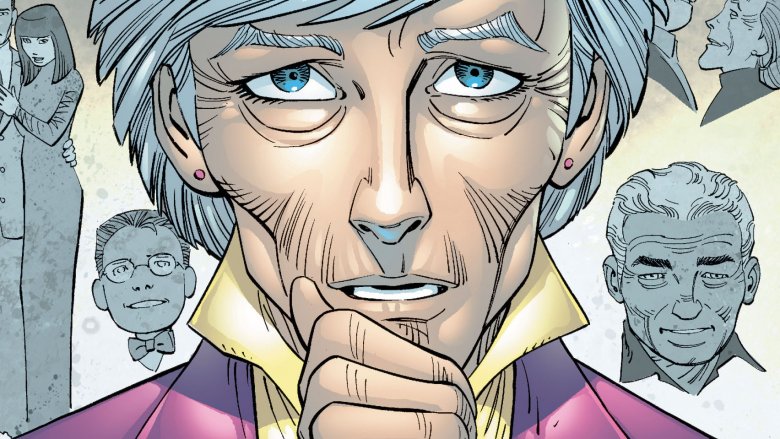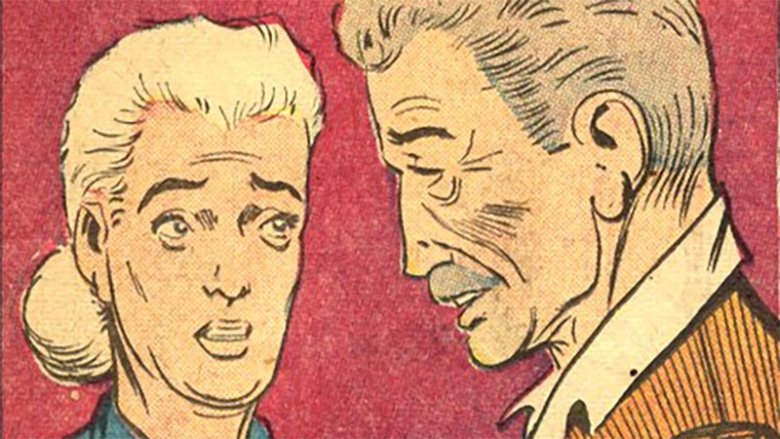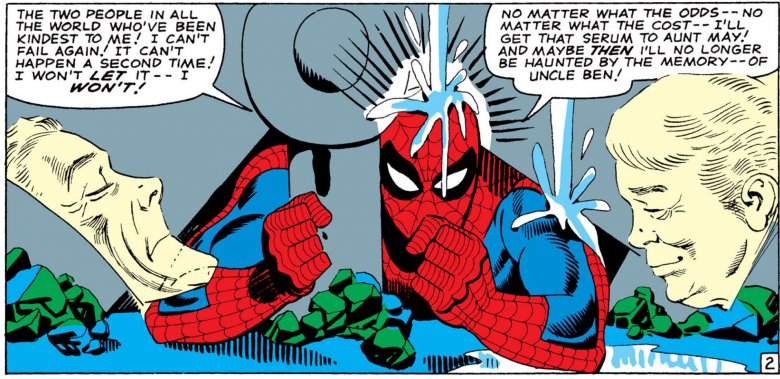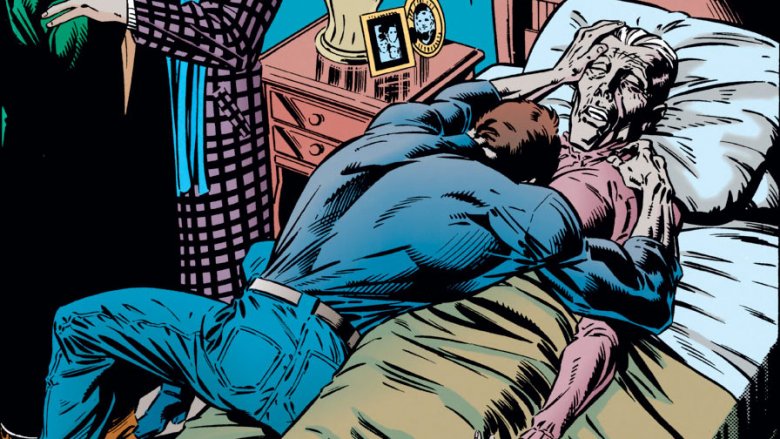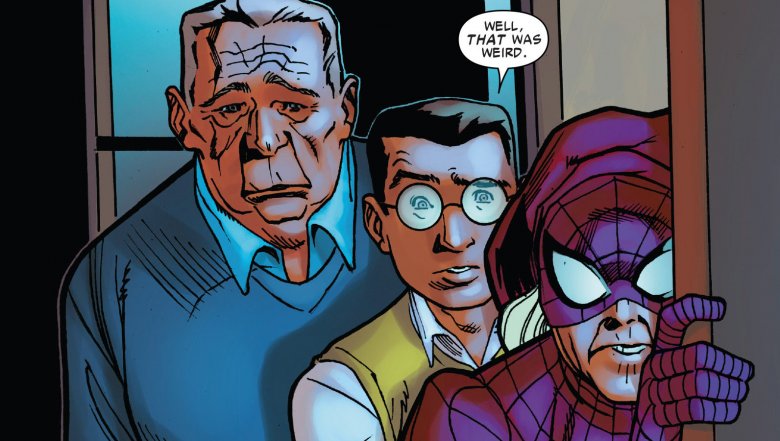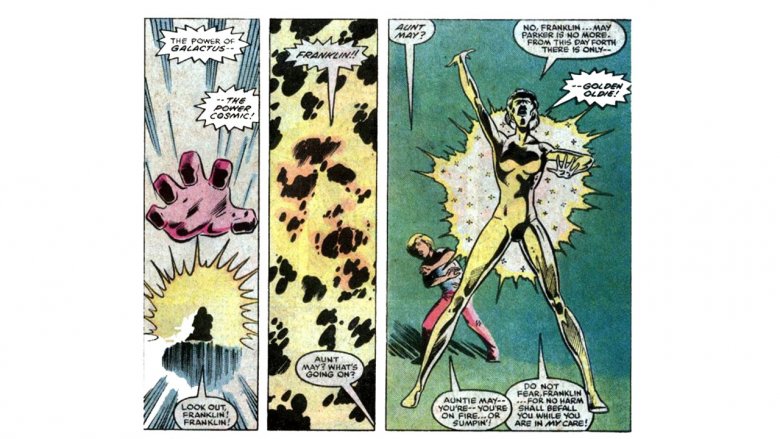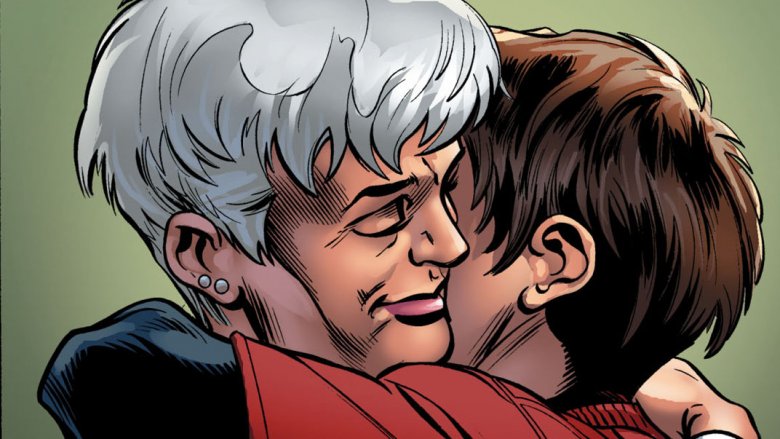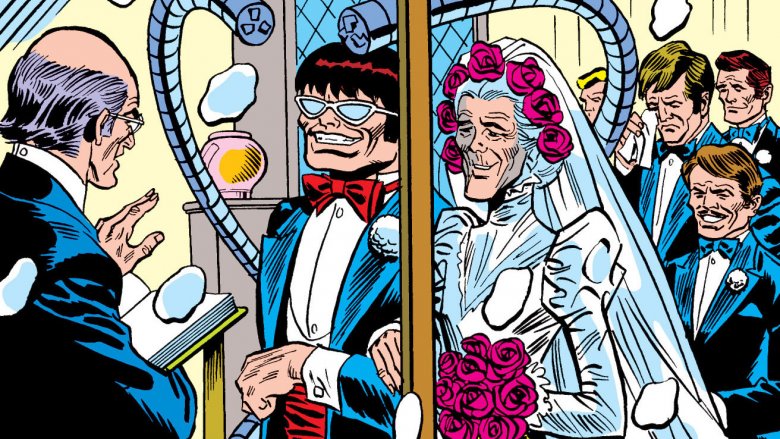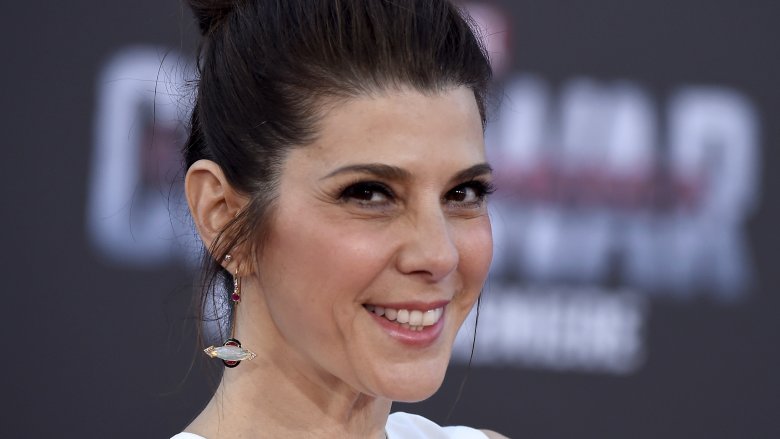The Untold Truth Of Aunt May
Spider-Man's biggest challenge isn't defeating foes like Doctor Octopus and the Green Goblin or finding the right balance between great power and great responsibility. It's Aunt May. In addition to fighting crime, Spidey must make sure that May has the medication and rent money that she needs to survive. When May's in trouble, he'll sacrifice anything—even his marriage—to save her.
But just because May's old doesn't mean that she's boring. She's a two-time widower who has been engaged five times. She's appeared in movies. She's tangled with Galactus, and has her own superhero identity. After all, there's a reason why May will always be the main lady in Peter Parker's life—and it's not just because she makes a mean batch of wheatcakes.
Early days
Officially, May and Ben Parker made their canonical debut alongside Spider-Man in Amazing Fantasy #15, but Spider-Man's origin story wasn't the first time that the characters had graced the pages of a Marvel comic. A couple of months before Spider-Man's big entrance, Stan Lee and Steve Ditko published a short story called "Goodbye to Linda Brown" in Strange Tales #97, which featured proto-versions of both of Peter's loving relatives.
Linda Brown is an unassuming wheelchair-bound teen who, like Peter Parker, lives with her Uncle Ben and Aunt May. Unlike everyone's favorite wall-crawler, however, Linda and her Aunt May reside in a quaint seaside bungalow, which provides easy access to the beach, where Linda spends time collecting seashells. One night, following a nightmare, she wakes up a few feet from her bed. Uncle Ben starts to worry that Linda is sleepwalking (or rolling—even unconscious, she gets into her wheelchair first) just like he and May do. The next night, Linda gets up and travels all the way to the sea, where she throws off the blanket covering her "legs" and dives into the sea—revealing that she's been a mermaid all along.
"Goodbye to Linda Brown" is only a few pages long and doesn't leave much room for character development, but both Ben and May show glimmers of their future selves. For one, they look very similar to their Amazing Fantasy counterparts (especially May—for some reason, the colorist decided to give Ben a grey mustache, although Ditko clearly didn't pencil one in). In addition, both spend most of their time fretting over a superpowered teenager, which is pretty much all that Aunt May did for the first 50 issues or so of Amazing Spider-Man (she fell ill a couple of times, too).
Big screen debut
While most of us probably saw Aunt May in the flesh for the first time in Sam Raimi's 2002 Spider-Man movie, in which Peter Parker's doddering aunt was played by Academy Award-nominated and Emmy-winning actress Rosemary Harris, the actress wasn't actually the first person to bring May to life in a live-action project. That honor goes to Jeff Donnell, who portrayed Aunt May in a 90-minute TV movie (which received a theatrical run overseas) that served as the backdoor pilot for the 1977 Spider-Man television series.
In Hollywood, Donnell wasn't a huge name, although she had featured roles in classic films like The Sweet Smell of Success and Tora! Tora! Tora!, as well as a number of B-level comedies and musicals including Nine Girls, Carolina Blues, and a couple of the Gidget flicks. For soap opera fans, Donnell is best known for her nine-year run on General Hospital, where she played Stella Fields right up until her death in 1988.
Donnell only played Aunt May in the Spider-Man pilot—for May's later appearances, the role was assumed by different actresses, including recurring Dennis the Menace star Irene Tedrow. And, of course, in the world of cartoons, many actresses tackled the Aunt May role before Harris immortalized her on the big screen. June Foray voiced May in Spider-Man and His Amazing Friends, in which the whole group operated out of May's Queens-based abode, but you probably know Foray better as the original voices of both Rocky the Flying Squirrel and his arch-nemesis, Natasha Fatale.
Peter Parker and Stan Lee's hero
If you're talking about classic issues of The Amazing Spider-Man, it's hard to get more iconic than The Amazing Spider-Man #33. The comic, which is titled "The Final Chapter," isn't actually co-creator Steve Ditko's final pass at Spider-Man—he'd provide art up through issue #38—but it does feel like the end of an era, and it puts Aunt May front and center.
As the story opens, Aunt May lies in a hospital bed, dying from a transfusion of Peter Parker's radioactive blood. The only cure is an isotope known as ISO-36, which is contained in an underwater lab controlled by Spider-Man's arch-nemesis, Doctor Octopus. As the laboratory fills with water, Spider-Man is pinned underneath multiple tons of fallen steel, with no hope of escape.
The following four pages are arguably Ditko's finest work in any Spider-Man comic—at least, that's what Stan Lee thinks. "The Spider-Man that was one of my all time favorite stories that was illustrated by Steve Ditko was the Spider-Man story called "The Final Chapter," Lee said. "It was such a thrill, even to me and I was the writer of the story. When I saw that I almost shouted in triumph. Steve did a wonderful job."
And who does Peter, and by extension Lee, have to thank for the big moment? Well, Ditko, of course, but also Aunt May. As the water rises, Spider-Man thinks about his beloved aunt, and how he's failed her in the past (namely letting the anonymous robber get away, leaving him free to kill Uncle Ben). Using May's strength and resilience as motivation, Peter lifts the steel beams above his head and escapes. He delivers the isotope to the hospital in the nick of time and, with May cured, puts the specter of Uncle Ben's death behind him once and for all (or, at least, until Stan Lee needed to send Peter Parker on another guilt trip).
The night Aunt May died?
The Amazing Spider-Man #121, in which the Green Goblin kills Peter Parker's girlfriend Gwen Stacy, is one of the most important superhero comics ever published, but it almost played out very, very differently. Originally, Gwen Stacy was going to make it to the end of The Amazing Spider-Man #121 alive and well—while Aunt May was going to meet her demise at the Goblin's hands instead.
That revelation comes from none other than long-time Spider-Man artist John Romita, who co-plotted The Amazing Spider-Man #121 with writer Gerry Conway. While talking to CBR, Romita confessed that he, and not Conway or Gil Kane (who penciled the issue), was Gwen Stacy's "murderer." As Romita tells the story, the original plan (Romita can't remember who came up with it, but thinks it might've been Conway) was to sacrifice Aunt May to the Green Goblin, but Romita pushed back on the idea, claiming that it would actually make The Amazing Spider-Man less dramatic. "It'll lose one of Peter Parker's hang-ups. He won't have to worry about Aunt May anymore. He won't be treated like a child anymore," Romita said. "If we want to make any kind of stir in the monthly line, we have to kill somebody important."
And so, Romita explained, the victim had to be "one of the main girls." From there, Gwen Stacy was the obvious choice. At the time, Mary Jane was "an airheaded comedy character" (although "The Night Gwen Stacy Died" had an epilogue that gave her some much-needed depth), while Gwen Stacy was the love of Peter Parker's life. In order to wring the maximum amount of emotional turmoil out of the story, Gwen Stacy had to go.
Not everybody is a fan
In Andrew Garfield's two outings as the old web-head, The Amazing Spider-Man and The Amazing Spider-Man 2, Sally Field brought Aunt May to life. So, how did the Academy Award-winning actress and former The Flying Nun star feel about bringing a comic book legend to life? In short, she hated it.
On The Howard Stern Show, Field reviewed The Amazing Spider-Man succinctly, stating, "It's not my kind of movie." When Stern asked if she liked the film at all, she said, "Not really." Apparently, that extended to May herself, too. "It's really hard to find a three-dimensional character in [the part]," Field said, before summing up her feelings with a more colorful metaphor: "You can't put 10 pounds of s**t in a five-pound bag."
So why did Field, who apparently doesn't like superhero movies or Aunt May, take the part in the first place? As Field explained, she agreed to appear in the Amazing Spider-Man films as a favor to filmmaker Laura Ziskin, who produced the first Amazing Spider-Man movie in addition to Sam Raimi's Spider-Man trilogy, Pretty Woman, and the Bill Murray comedy What About Bob? While The Amazing Spider-Man was being filmed, Ziskin was battling breast cancer, and Field agreed to take the part in order to help out her long-time friend. "We knew it would be her last film," Field said.
Sadly, she was right. Ziskin passed away on June 12, 2011, a few months after The Amazing Spider-Man finished filming, but over a full year before the movie hit theaters.
Her very own secret identity
Aunt May doesn't just fret about a superhero's well-being—she's also a superhero herself. Sort of. In What If #23, a back-up feature called "What if Aunt May instead of her nephew Peter had been bitten by that radioactive spider?" tells the story of—well, it's all right there in the title.
In Amazing Fantasy #15, Peter attends the scientific demonstration where he crosses paths with the radioactive spider by himself. In What If #23, he leaves his bagged lunch at home, and Aunt May rushes to the Science Institute to deliver it. While she's there, the spider bites May on the hand, and her spider-powers kick in on the walk home. May quickly sews herself a costume and creates a unique version of Spider-Man's web-fluid out of some over-yeasted dough. Before long, she's taken to the streets as Spider-Ma'am, juggling her crime-fighting career with her familial responsibilities.
And while What If stories aren't canonical, writer Christos Gage and artist Dave Williams made Spider-Ma'am a reality in Spider-Verse Team-Up #3, part of Dan Slott and Olivier Coipel's dimension-hopping epic, Spider-Verse. In the comic, a team of Spider-Men (including the Peter Parker that we know and love) travel to Earth-3123 to rescue Spider-Ma'am from Karn, an interdimensional hunter with a mad-on for everything spider-related. It works, but there's one casualty: during the battle, Spider-Ma'am reveals her secret identity to her husband and nephew. Their lives will never be the same.
Interstellar snack cake pusher
The list of people who have stopped Galactus, Marvel Comics' gargantuan devourer of worlds, is pretty short. The Fantastic Four have done it, of course. So have Thanos and the Beyonder, another two of Marvel's cosmic characters. Galactus' former right-hand man, the Silver Surfer, defeated his former master in an alternate universe, while Aunt May took him down with the help of Franklin Richards—but not before becoming one of his all-powerful heralds.
This tale took place in Marvel Team-Up #137, which was part of Marvel's "Assistant Editor's Month," an event in which some of Marvel's top creators were given free reign to tell the wildest—and silliest—stories they could imagine. In the comic, Spider-Man and the Fantastic Four head off to San Diego to thwart an unnamed disaster, leaving Reed Richards and Sue Storm's superpowered son Franklin in Aunt May's care. Unfortunately, just after the real heroes leave town, Galactus arrives in search of a new herald—and he's got his sights set on Franklin. One ill-aimed energy blast later, and Aunt May is transformed into the Golden Oldie, a glowing super-heroine infused with the power cosmic.
Thanks to Galactus, all of Aunt May's health problems—her arthritis, her vitamin deficiencies, her bingo-addiction—are gone. But there's a catch: Galactus is hungry, and it's up to his herald to keep him fed. At Franklin's prompting, May feeds Galactus a Twinkie. He loves it, and demands more.
Using her newfound powers, May scours first Earth and then the entire galaxy for more of the spongy, cream-filled snack cakes. In her travels, she meets an alien that looks a lot like the Pillsbury Dough Boy who just happens to make planets that resemble Hostess products. At May's suggestion, Galactus takes the alien on as his new herald and frees May from her responsibilities. When she returns home, Franklin absorbs all of May's cosmic powers, and everything goes back to normal—right before writer Michael Carlin reveals that the whole adventure is just a bad dream... or was it? (It was.)
All in the family
In October 2000, Marvel launched Ultimate Spider-Man by Brian M. Bendis and Mark Bagley. The series, which was completely separate from the long-established Marvel canon, was intended to create a brand new, continuity-free entry point for new readers by taking Spider-Man's classic origin story and rebuilding it from the ground up. While, like in the regular Spider-Man comics, Aunt May serves as both Peter's caretaker and emotional anchor, in Ultimate Spider-Man she's younger, tougher, and remarkably savvy, representing a major shift from May's traditional sickly, doddering portrayal.
In fact, as time goes on, Aunt May develops into one of the most interesting and complex characters in the entire Ultimate universe, and with good reason: Bendis says that Ultimate Aunt May is "a dead on impression" of his own mother. "What I do is try to look for people in my life that remind me of that person or have something about that person that I know I could write as true," Bendis told Bookslut. "My mom is such a rich personality and such a strong person, but so emotional. I dug in there."
By all accounts, Bendis nailed the likeness, too. "When my brother read it he went, 'Jesus Christ. That is right on the money,'" Bendis quipped in an interview with CBR. His mom wasn't quite as pleased, at least not at first. "She's not sure if I'm making fun of her or not. But I'm not. It's really a nice valentine to her," Bendis says. "She knows now. At the time, she was like, 'Are you making fun of me in this?' And I was like, 'No, no, no.'"
A woman about town
Peter Parker will always be the main man in May Parker's life, but with such a busy day-to-day life—in addition to his web-crawling duties, Peter has worked as a freelance photographer, a high school science teacher, a research scientist, the CEO of a global tech company, and more—May's nephew doesn't always have time for his beleaguered aunt. Thankfully, despite her age, May is incredibly popular with the fellas, and has accumulated quite a collection of lovers to keep her company while Peter's away.
There was Ben Parker, of course, who met his tragic demise in Amazing Fantasy #15, but before Ben and May got hitched, she almost married a criminal named Johnny Jerome, who tried to win her heart by offering her lots and lots of money (and who returned to plague her in The Spectacular Spider-Man Annual #4). In The Amazing Spider-Man #54, Doctor Octopus rents May's spare room, and wins her over with his erudite charms—in The Amazing Spider-Man #131, he actually tries to marry her in order to steal her inheritance, although Hammerhead and Spider-Man interrupt the wedding before it's finalized.
Throughout the '80s, May dated Nathan Lubensky, a reformed gambling addict who asked May to marry him before he relapsed, fell afoul of the Vulture, and died in Amazing Spider-Man #336. In the early '90s, she enjoyed a brief fling with the Fantastic Four's long-time mailman Willie Lumpkin. After Peter Parker and Aunt May moved to Stark Tower in the buildup to Civil War, May and Tony Stark's butler, Jarvis, shared a mutual attraction. Finally, May dated and married J. Jonah Jameson's father, John Jameson, Sr., and stayed with him until he died of a rare hereditary disease in The Amazing Spider-Man #19.
How old, again?
Aunt May actress Rosemary Harris was 75 in 2002, when Sam Raimi's Spider-Man hit theaters. When she appeared as May in The Amazing Spider-Man, Sally Field was 66. By contrast, Marisa Tomei, who plays May in Captain America: Civil War and Spider-Man: Homecoming, was only 50 when she first starred as Peter Parker's favorite aunt.
That is significantly younger than May is usually portrayed—in Civil War, Tony Stark even jokes about it, teasing Peter Parker about his "hot aunt"—but don't blame Tomei. While appearing on The Late Show with Stephen Colbert, Tomei revealed that she actually petitioned Marvel to make May into a senior citizen, but the studio declined. "You can imagine my horror when I was cast and I started doing the research," Tomei explains, "but then I thought 'well, I'm going to go with it.' And I actually made a case to go, to age me up, but no they didn't do it."
Besides, as Civil War co-writer Stephen McFeely notes, a younger Aunt May makes perfect sense, given that Tom Holland's Peter Parker is still in high school. "That's partly why his aunt isn't 80 years old," McFeely told the Los Angeles Times. "If she's the sister of his dead mother, why does she have to be two generations ahead?" In other words, Homecoming's Aunt May isn't too young—in the comics, she's too old.
